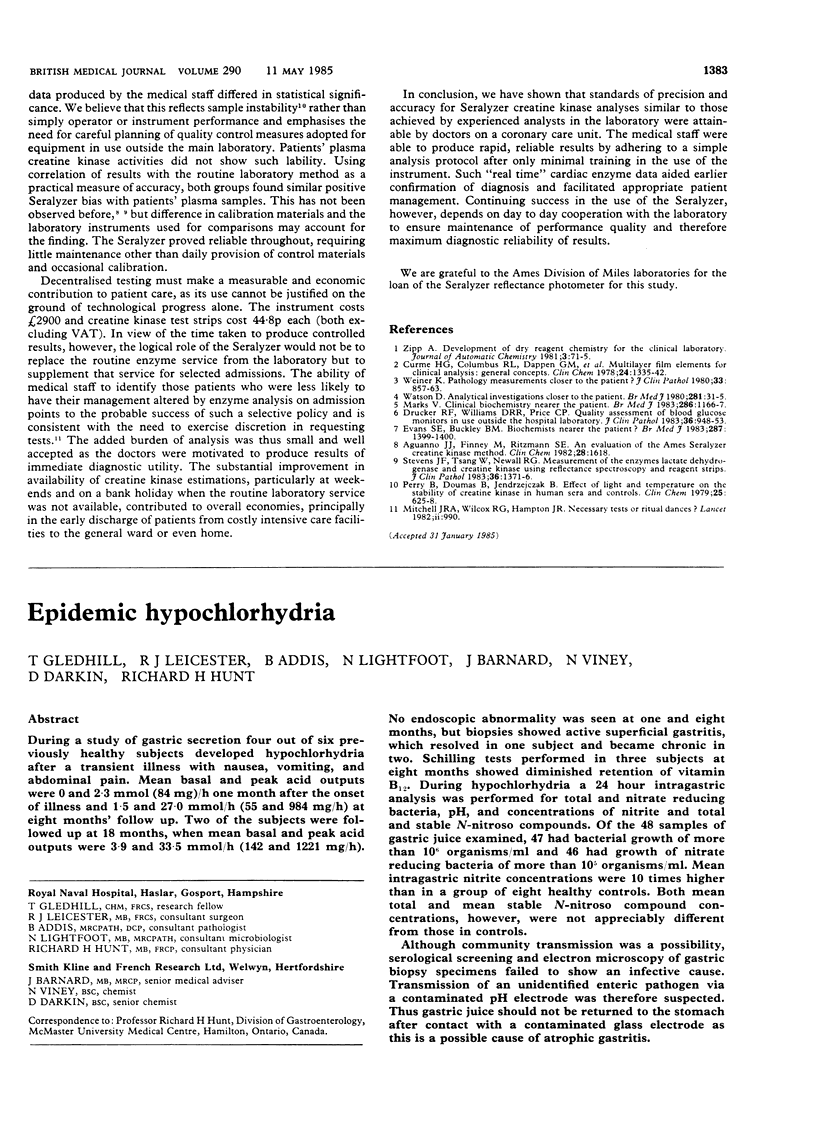Abstract
During a study of gastric secretion four out of six previously healthy subjects developed hypochlorhydria after a transient illness with nausea, vomiting, and abdominal pain. Mean basal and peak acid outputs were 0 and 2.3 mmol (84 mg)/h one month after the onset of illness and 1.5 and 27.0 mmol/h (55 and 984 mg/h) at eight months' follow up. Two of the subjects were followed up at 18 months, when mean basal and peak acid outputs were 3.9 and 33.5 mmol/h (142 and 1221 mg/h). No endoscopic abnormality was seen at one and eight months, but biopsies showed active superficial gastritis, which resolved in one subject and became chronic in two. Schilling tests performed in three subjects at eight months showed diminished retention of vitamin B12. During hypochlorhydria a 24 hour intragastric analysis was performed for total and nitrate reducing bacteria, pH, and concentrations of nitrite and total and stable N-nitroso compounds. Of the 48 samples of gastric juice examined, 47 had bacterial growth of more than 10(6) organisms/ml and 46 had growth of nitrate reducing bacteria of more than 10(5) organisms/ml. Mean intragastric nitrite concentrations were 10 times higher than in a group of eight healthy controls. Both mean total and mean stable N-nitroso compound concentrations, however, were not appreciably different from those in controls. Although community transmission was a possibility, serological screening and electron microscopy of gastric biopsy specimens failed to show an infective cause. Transmission of an unidentified enteric pathogen via a contaminated pH electrode was therefore suspected. Thus gastric juice should not be returned to the stomach after contact with a contaminated glass electrode as this is a possible cause of atrophic gastritis.
Full text
PDF



Images in this article
Selected References
These references are in PubMed. This may not be the complete list of references from this article.
- Desai H. G., Antia F. P. Spontaneous achlorhydria with atrophic gastritis in the Zollinger-Ellison syndrome. Gut. 1969 Nov;10(11):935–939. doi: 10.1136/gut.10.11.935. [DOI] [PMC free article] [PubMed] [Google Scholar]
- Desai H. G., Zaveri M. P., Antia F. P. Spontaneous and persisting decrease in maximal acid output. Br Med J. 1971 May 8;2(5757):313–315. doi: 10.1136/bmj.2.5757.313. [DOI] [PMC free article] [PubMed] [Google Scholar]
- Fordtran J. S., Collyns J. A. Antacid pharmacology in duodenal ulcer. Effect of antacids on postcibal gastric acidity and peptic activity. N Engl J Med. 1966 Apr 28;274(17):921–927. doi: 10.1056/NEJM196604282741701. [DOI] [PubMed] [Google Scholar]
- HIRSCHOWITZ B. I., LONDON J. A., POLLARD H. M., STREETEN D. H. A steroid-induced gastric ulcer. Lancet. 1956 Nov 24;271(6952):1081–1083. doi: 10.1016/s0140-6736(56)90214-8. [DOI] [PubMed] [Google Scholar]
- LAWRIE R. S., WILLIAMSON A. W., HUNT J. N. Zollinger-Ellison syndrome treated with poldine methyl methosulphate. Lancet. 1962 May 12;1(7237):1002–1004. doi: 10.1016/s0140-6736(62)92037-8. [DOI] [PubMed] [Google Scholar]
- Milton-Thompson G. J., Lightfoot N. F., Ahmet Z., Hunt R. H., Barnard J., Bavin P. M., Brimblecombe R. W., Darkin D. W., Moore P. J., Viney N. Intragastric acidity, bacteria, nitrite, and N-nitroso compounds before, during, and after cimetidine treatment. Lancet. 1982 May 15;1(8281):1091–1095. doi: 10.1016/s0140-6736(82)92277-2. [DOI] [PubMed] [Google Scholar]
- Nalin D. R., Levine R. J., Levine M. M., Hoover D., Bergquist E., McLaughlin J., Libonati J., Alam J., Hornick R. B. Cholera, non-vibrio cholera, and stomach acid. Lancet. 1978 Oct 21;2(8095):856–859. doi: 10.1016/s0140-6736(78)91568-4. [DOI] [PubMed] [Google Scholar]
- Ramsey E. J., Carey K. V., Peterson W. L., Jackson J. J., Murphy F. K., Read N. W., Taylor K. B., Trier J. S., Fordtran J. S. Epidemic gastritis with hypochlorhydria. Gastroenterology. 1979 Jun;76(6):1449–1457. [PubMed] [Google Scholar]
- Ruddell W. S., Axon A. T., Findlay J. M., Bartholomew B. A., Hill M. J. Effect of cimetidine on the gastric bacterial flora. Lancet. 1980 Mar 29;1(8170):672–674. [PubMed] [Google Scholar]
- SPIRO H. M., SCHWARTZ R. D. Superficial gastritis; a cause of temporary achlorhydria and hyperpepsinemia. N Engl J Med. 1958 Oct 2;259(14):682–684. doi: 10.1056/NEJM195810022591406. [DOI] [PubMed] [Google Scholar]
- Siurala M., Isokoski M., Varis K., Kekki M. Prevalence of gastritis in a rural population. Bioptic study of subjects selected at random. Scand J Gastroenterol. 1968;3(2):211–223. doi: 10.3109/00365526809180125. [DOI] [PubMed] [Google Scholar]
- Siurala M., Isokoski M., Varis K., Kekki M. Prevalence of gastritis in a rural population. Bioptic study of subjects selected at random. Scand J Gastroenterol. 1968;3(2):211–223. doi: 10.3109/00365526809180125. [DOI] [PubMed] [Google Scholar]
- Waterfall W. Spontaneous decrease in gastric secretory response to humoral stimuli. Br Med J. 1969 Nov 22;4(5681):459–461. doi: 10.1136/bmj.4.5681.459. [DOI] [PMC free article] [PubMed] [Google Scholar]
- Wiersinga W. M., Tytgat G. N. Clinical recovery owing to target parietal cell failure in a patient with Zollinger-Ellison syndrome. Gastroenterology. 1977 Dec;73(6):1413–1417. [PubMed] [Google Scholar]




